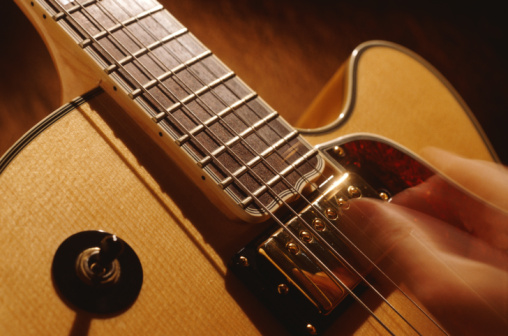by Arlen Roth
When I play country or rockabilly on electric, I inevitably slip into the alternating-bass “Travis picking” style. But while Merle Travis and most other players associated with the style use the thumb to play the bass notes, I prefer to use the flatpick, with my middle and ring fingers sounding the lead notes on top. Although the style originated among pure fingerpickers like Merle Travis, Ike Everly, Chet Atkins, and Joe Maphis, contemporary players (such as Eric Johnson and the late Danny Gatton) also use the pick-and-fingers method.
The advantage of this method is that you can switch from straight flatpicking to fingerpicking in a flash, and the flatpick gives the bass notes a good “edge.” The disadvantage is that you lose the use of the index finger, which must grip the pick.
Some traditional players get around this by using a thumbpick for the bass notes, freeing three fingers for the lead parts; when they have to break into a single note line without a bass part, the thumbpick plays part of the flatpick. I don’t know about you, but I have a hard time grasping the concept of using my thumb to play lead. My style is the direct outgrowth of being a lead player, someone who needs to switch from technique to technique minimum of effort. Read on for the full guitar lesson including audio, charts, power tab, and more…
Guitar Lesson
http://truefire.com/audio-guitar-lessons/rockabilly-fingerstyles.mp3
Click here to download the power tab for this guitar lesson.
Notice how the open strings help you play licks over the E and A7 chords in Ex. 1, and how you can incorporate hammer-ons in the lead part. When you get to the B7 chord, the 2nd fretting-hand finger must alternate between the fifth and sixth strings. This is a classic Travis-type technique, so it would be good to get it down.
We take it up the neck a bit for Ex. 2. Even though we’re working in a more closed position, we still rely on the open fifth string. Note that the lead notes are often pinched simultaneously with a bass note.
Ex. 3 shows the possibilities-and limitations-of working in a totally closed position, in this case the key of G.-We must maintain a complete barre chord across all six strings while slipping in some notes on top of the bass line. This one may be a little uncomfortable at first, so take your time with it.
Constant Bass
Another common rockabilly picking style used by players such as Cliff Gallup (with Gene Vincent and the Blue Caps), Carl Perkins, Scatty Moore, and others-uses a constant-bass sound.
I think the toughest aspect of this style is maintaining the separation between the bass and lead notes. A good way to achieve this independence is to practice parts in which the lead figures relate well to the bass patterns. For example, try playing a shuffle eighth-note feel in the bass against a triplet pattern on top, as in Ex. 4. This three-notes-for-two situation helps “lock” your picking hand into a groove. Once that groove is established, you can take chances and go off on more exploratory lead ventures.
Another popular approach uses straight eighth-notes in the bass, as in Ex 5. Lefthand techniques such as slides, hammers, and pull-offs all lend character and independence to the lead part.
Start both exercises with just the bass lines, and then lay the lead parts over them once the bass feels locked in.
